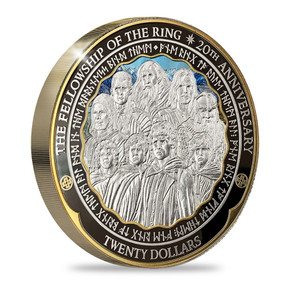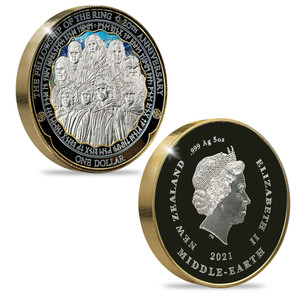Peter McIntyre (1910-1995) was the best known New Zealand artist through the middle decades of the 20th century.
Issue information
His father (Peter McIntyre senior) was also an artist and it was he who persuaded the younger Peter to abandon his journalism course in Dunedin and take up study at the Slade School of Arts in London. Three years at art school, with working holidays on the Continent, were followed by some financially difficult years in London working as a stage designer and decorator for Sadler's Wells Theatre, as well as part time work as a magazine illustrator.
He joined the NZ Division at the start of World War II, spending his first year as a gunner. On seeing his talent for drawing and painting General Freyberg promoted him to Official War Artist and he recorded a visual history that captured the emotions of New Zealanders at war in Crete, mainland Greece, North Africa and Italy. Once he became the Official War Artist, his stated aim was "to give a more instant and intimate impression of the drama, the colour, the humour and the tragedy of war". McIntyre avoided taking a political approach with his war paintings, his objective being to capture the feelings of the New Zealander at war. His camaraderie with fellow New Zealanders during the war encouraged him to return home.
Once home, McIntyre sought to create paintings that conveyed a sense of the uniqueness and beauty of New Zealand - both through the people and landscape and he chose a representational method, that gave his work an accessibility and a popularity seldom before seen in New Zealand. During the period when he was engaged with the local environment, he also took working trips to other locations of interest which included Antarctica, Hong Kong, the Northern Territory of Australia and Europe. In 1962 the first of his many books The Painted Years was published. More books followed over the years and they provided an introduction to art for many New Zealanders and established him as an artist with a large public following. He was seen as a practical, unpretentious artist easily able to communicate with his fellow New Zealanders.
This tribute was the second in the New Zealand Art series and followed on from the inaugural issue in 1997 that paid tribute to the genius and striking originality of Colin McCahon. It featured four works from throughout Peter McIntyre’s long and illustrious career.
Product Listing for New Zealand Art - Peter McIntyre
| Image | Title | Description | Price |
|---|---|---|---|
 |
Single Stamp |
Single 40c 'Wounded at Cassino, 1944' gummed stamp. By 1944 the New Zealand Division had moved form the wide open spaces of the Western Desert in North Africa to the hills and villages of central Italy. In Africa battles were characteristically mobile and fought over empty terraine. McIntyre often included these ageless empty landscapes as backdrops to the intense human drama unfolding before them. He was also interested in conveying something of the special qualities of the New Zealander at war, not necessarily as hero but rather as an ordinary person placed in extraordinary circumstances. Equally he was concerned to express the feelings, the emotions and the camaraderie amongst soldiers. In Italy, both civilians and priceless cultural icons were at risk for the battles raging through the country. Nowhere was this more visible that in the Cassino campaign where one of the treasures of civilisation (the monastery at Monte Cassino) was at stake. By the time McIntyre reached Monte Cassino both landscape and building had been reduced to rubble. In Wounded at Cassino, 1944, McIntyre captures a moment in the battle using a style reminiscent of work by British World War One artists with whom he was familiar from his days at the Slade School of Art in London. Characteristically he was able to adapt his painting style to suit the environment and spectacle confronting him. He would, for example employ colours and brush strokes in ways which convey the energy and drama of war. In this painting detail is sacrificed for a summary impression. Professor John Roberts, writing about this work states, "the rubble, the pain and above all, the sense of offended humanity are compelling".
|
$0.40 |
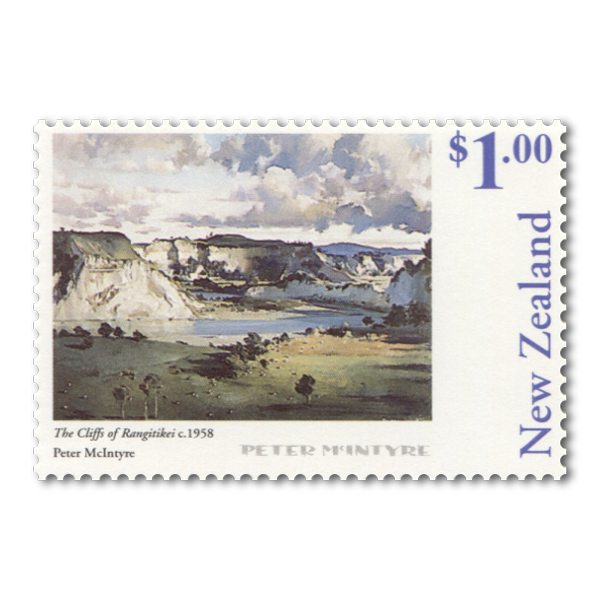 |
Single Stamp |
Single $1.00 'The Cliffs of Rangitikei, c. 1958' gummed stamp. One of Peter McIntyre's favourite pastimes was fly fishing, and after moving from Dunedin to Wellington in the late 1940's he made many fishing excursions to the Taupo region. Each of these trips took the artist through the central North Island and past the Rangitikei River with its spectacular white cliffs and curving river bed. The visual contrasts, drama and natural formations of the scenery held immediate attraction and he continued to paint scenes from the area for the rest of his life. As McIntyre himself said "for years I carried on a love affair in paint with this river, wandering in its valley, prowling the fields above it, waiting for the sun to light the splendour of its white papa cliffs". The painting is an early example, but it vividly displays the sense of drama with high contrasting lights and darks, and exemplifies the artist's ability to capture the landscape in a memorable way. The painting is executed with deft handling and incorporates a sublime sense of space. Broad, confident strokes of paint convincingly recreate the field, cliff or tree. Although a realistic painting in the traditional sense, detailed areas of the image can easily be read in a more abstract way. These cliffs became one of McIntyre's most frequent motifs so that, more than any other subject, he became recognised and respected for his Rangitikei paintings. |
$1.00 |
 |
Single Stamp |
Single $1.50 'Māori Children, King Country, 1963' gummed stamp. In his book Kākahi Peter McIntyre wrote this of Māori children he had painted so often, "Behind their shyness, lies a Polynesian beauty very similar to that of Tahitians". He was deeply concerned by the plight of Māori, particularly the impact of urban drift on their heritage and future. It was in his paintings of Māori people and Māori children in particular, that McIntyre came closest to making social or political comment. McIntyre's concern led to his advocacy for a greater awareness in New Zealand of Māori culture, most especially to enhance the mana and confidence of Māori children. McIntyre was thinking, writing and painting with these ideas in the 1950s and 60s when little attention was given to such issues. As a consequence McIntyre was held in high regard by the local Māori community at Kākahi, who often referred to him as a taonga or 'treasure'. Natural artistic facility, years of classical training, and the finely tuned observational skills developed as a war artist gave Peter McIntyre an ability to capture the warmth and character of the Māori children he depicted in hundreds of drawings and paintings. In this particular painting his deft handling of paint is evident in the skilful rendering of the children's faces and of the flax kit held by the girl. The background is formed by broad sweeps of a palette knife, a method favoured by the artist throughout the 1960s. This painting, featured on the cover of his book, ‘Peter McIntyre’s New Zealand’ - the book which brought him into prominent view. |
$1.50 |
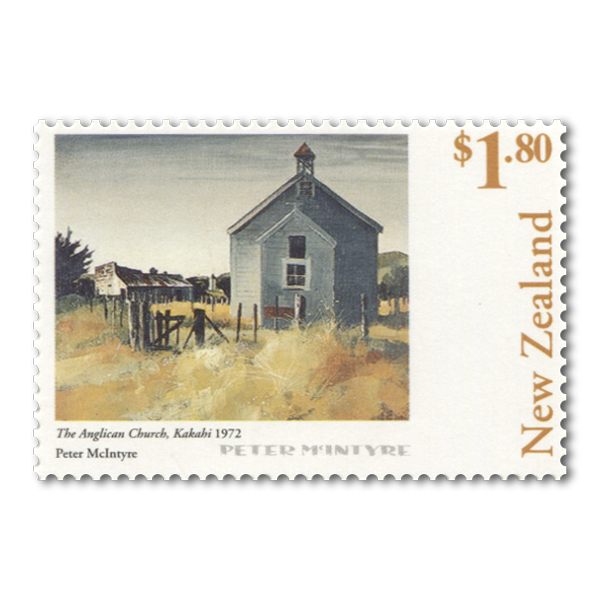 |
Single Stamp |
Single $1.80 'The Anglican Church, Kākahi, 1972' gummed stamp. Kākahi beame a pivotal place in the career of Peter McIntyre. From his first visit in 1960 he fell in love with the village, its environs and especially the rivers nearby. After building a fishing cottage and studio overlooking the Whakapapa River he continued to paint over the next 30 or so years. Concentrated into this sleepy little valley he saw much that was unique and special about New Zealand. In particular he loved the rambling, weathered buildings of the village, "with its haunting sense of time past, it sits with a seedy charm like a western movie set awaiting actors". While change strode through the New Zealand landscape, McIntyre fought to preserve the peace and quiet of remote rural areas like the King Country. Of this painting he wrote "the Anglican Church and beyond it the old smithy in the brooding twilight. It is a place, unconcerned with time". This painting contains many of the features that characterised McIntyre's approach and philosophy for his New Zealand paintings. The work has dramatic light and a strong sense of atmosphere, with old buildings set against the evening sky and all finished with his trademark flourish of paint to depict the foreground tussock grass. |
$1.80 |
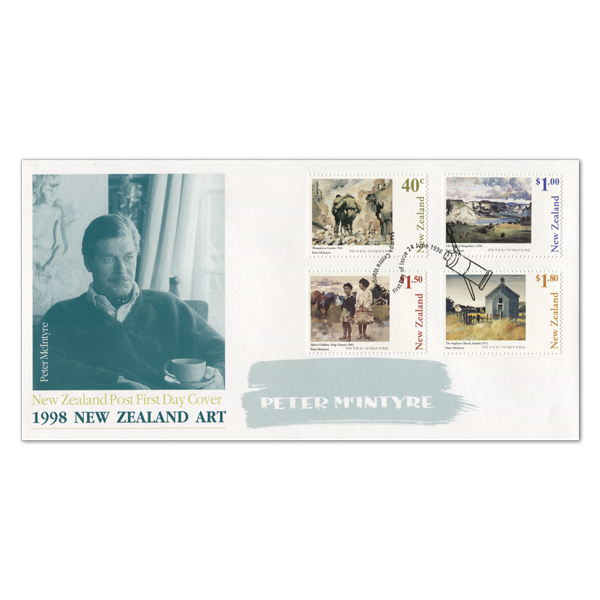 |
First Day Cover | First day cover with stamps affixed. Cancelled on the first day of issue. | $5.20 |
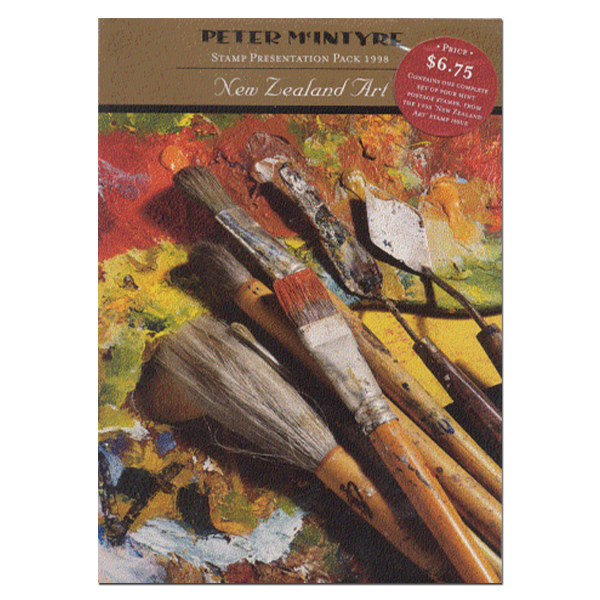 |
Presentation Pack | Presentation pack containing a selection of stamp products from the issue and further information on the theme of the stamps. | $6.75 |
 |
Limited Edition | Limited edition collectable containing exclusive stamp products not available anywhere else. | $135.00 |
Technical information
| Date of issue: | 24 June 1998 |
|---|---|
| Number of stamps: | Four |
| Denominations and designs: | 40c Wounded at Cassino (1944); $1.00 The Cliffs of Rangitikei (c.1958); $1.50 Māori Children, King Country (1963); $1.80 The Anglican Church, Kākahi (1972) |
| Stamps and first day cover designed by: | Hamish Thompson, Wellington, New Zealand |
| Printer and process: | Southern Colour Print, New Zealand by lithography |
| Number of colours: | Four process colours and one special non-common PMS colour per stamp |
| Stamp size and format: | 44.12mm x 30mm (horizontal) |
| Paper type: | 104gsm red phosphor coated Litho stamp paper |
| Number of stamps per sheet: | 50 |
| Perforation gauge: | 13.34 x 13.6 |
| Cost of unadressed first day cover: | $5.20 |
| Special blocks: | Plate/imprint, positional or value blocks could be obtained by purchasing at least six stamps. Colour blocks ('traffic lights') were included in plate blocks. Barcode blocks were available in both A and B formats. |
| Period of sale: | These stamps remained on sale until 24 June 1999. |



